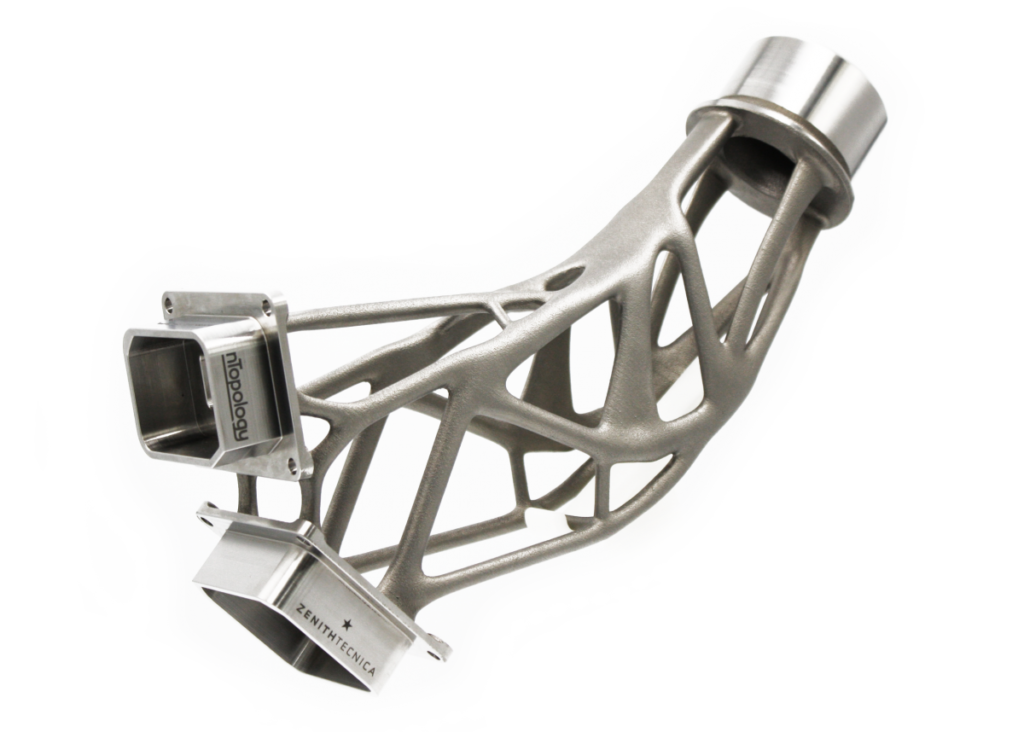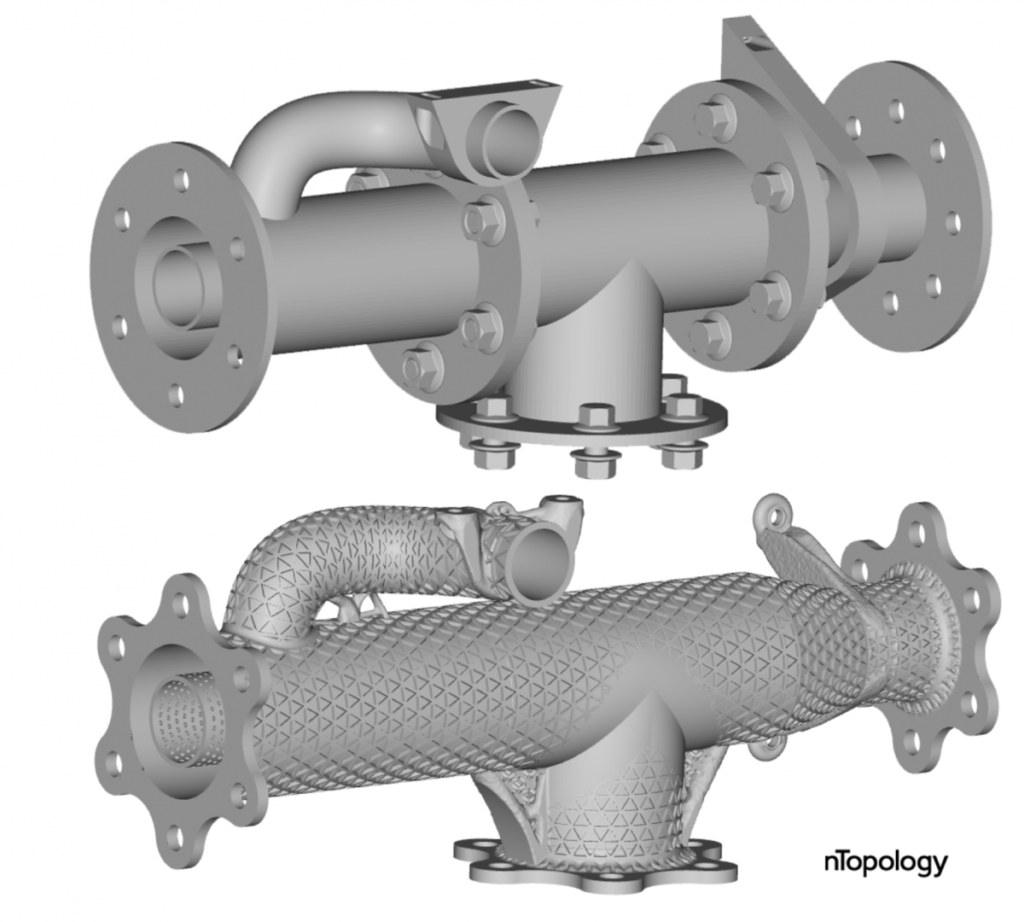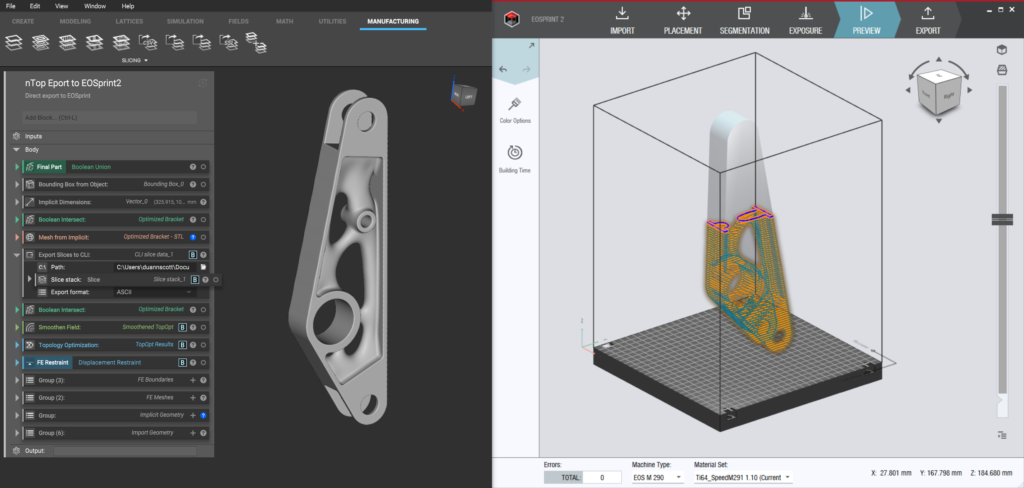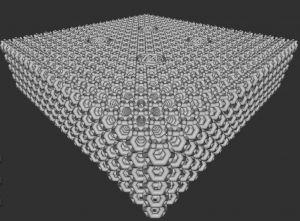Sometimes you make mistakes, I helped get Duann Scott a job at Shapeways and like some winding triangle constructed Banquo’s ghost he’s haunted all my tradeshows since. After stints at Shapeways and Autodesk, he’s now landed a plum job at something called nTopology, ntop for intimi. Unable to fly, fly, fly much longer I decided to meet with Duann at Formnext. Or actually I wanted to meet with someone called Blake who is like super nice and stuff; to everyone but me. Instead, in his absence, I was forced to bite the bullet and met with his surrogate, Duann.

Leigthweigthed and topology optimized bracket.
Initially, I thought that ntop was kind of a 3D printed barber salon or some kind of fourth-wave coffee bar (without the ability to give one coffee). I think everyone asked to look at the finest mustaches, beards, and tattoos in 3D printing will correctly infer that nTopology is based in New York. What these hipster triangle rustlers are up to however may be a matter more difficult to discern. Nestled around the corner of the home of the croconut, and adjacent to Vespa Manhattan, nTopology wants to change the way things are designed and made.

Lightweighting via nTop.
The promise of nTopology is that they have found a way to combine simulation and design for complex parts in one fast application. ntop is kind of what would happen if Ansys, AutoCAD, and Grasshopper had some kind of CRISPR clone child that was raised on meth and Red Bull. nTopology lets you simulate, do Design of Experiments, lightweight, design for additive, reduce part count during the design phase of your project. Rather than serially using different programs requiring a part to be designed, then simulated, then redesigned, then maybe designed for additive, and then maybe ping pong back and forth a few times; this could all be taken into account of and done from the start in one application. What’s more, nTpopology will do this faster than other products so that calculation and wait times are reduced from days to hours or even minutes.

nTop lets you export directly to EOSPrint bypassing STL
Duann says that, “what nTop does is enable geometries that other software can not.” “Existing CAD software uses b-reps or boundary representations to represent a geometry through NURBS, cones or faces. These legacy b-rep or mesh-based tools simply can not keep up with the latest geometry. New designs that can be produced through Additive Manufacturing require a complexity of parts that is too complex for many design software packages.” He cites the example of a “complex heat exchanger with many millions of polygons in an STL” and states that “just rotating this or making the slightest adjustment will cost a lot of time.”

Lattices are hip and they spit out triangles like there is no tomorrow. High-performance lattice structures could perform much easier in nTop.
“In one example such a heat exchanger could have 10,000 cells in a lattice structure this model would take 6 days to generate in b-rep software and two minutes in nTop.”
“In some cases with very complex files making a change can take hours or days, with us minutes. With nTop we can print it and slice it straight with the same tool” and “we completely bypass issues with the mesh.”
Duann mentioned that, “nTopology uses Signed Distance Functions where function gives a value for every point in a given 3D space, an SDF of a solid is negative when the corresponding point is inside the object and positive when it is outside.” Rather than dividing up the surface of a thing as good as possible in triangles and then mapping this entire patchwork nTop uses a mathematical function that returns the values that describe this area. When calculating changes, renders and operations traditional CAD runs through all the triangles, their locations and face normals before then calculating where what will be displayed or changed. nTop meanwhile solves the functions, speeding up the calculations considerably. Duann says that “due to these mathematical equations our geometries do not fail” and “since everything is an equation, it doesn’t matter how complex it is.”
With FEA and designed for 3D printed parts we often have lattice structures and very complex files and specifically for these cases nTop seems like it could make a difference. Duan believes that it gets even better if “you have 120 SKU and you would like to change or create new surface geometry for all of these parts. In the case of a spinal cage, for example, you may want to change all of the surface geometry in one go. With nTop you can apply the new cup geometry to all of the parts and essentially run it as a script.” He goes on to say, “what we’ve created with nTop is a programming language for geometries.” He thinks that, “this will be especially valuable in aerospace and medical” where their subscription software could “make a difference..where each time you make a change it could take days to draw that grid normally. This becomes especially relevant in these markets where we see users do lots of iterations.” Now with nTop “iteration is happening in a linear process” and we can “use the same recipe again and again to in seconds implement change.” What it also allows for is for “one advanced engineer to test and evaluate a design” who then “gives this toolkit to others who then conduct Design of Experiments.”
nTop seems like it may be a new design tool for a new more agile age of manufacturing. It faces an uphill struggle against the huge installed bases of the traditonal CAD packages but if in complex geometries the tool can outperform as advertised, then nTop’s 80 strong team will be getting reinforcements to bring the battle to the major players. For now, the team’s crusade against the hated STL file type is one that I can get behind.
Subscribe to Our Email Newsletter
Stay up-to-date on all the latest news from the 3D printing industry and receive information and offers from third party vendors.
You May Also Like
3D Printing News Briefs, April 27, 2024: Research, Digital Dentistry, Cycling, & More
We’re starting today’s 3D Printing News Briefs with some research into 3D printed luminescent quantum-dot polymer architectures and free-form laser beam shaping, and then on to an open source 4-axis...
HP & INDO-MIM Collaborate to Boost Metal 3D Printing in India
HP Inc. and INDO-MIM, a US- and India-based supplier of metal injection molding (MIM) powders and contract manufacturer, have announced that the two companies will collaborate to accelerate additive manufacturing...
3D Printing News Briefs, February 17, 2024: Shot Blasting, Service Bureaus, & More
In today’s 3D Printing News Briefs, we’re starting out with post-processing, as SKZ Würzburg is using a shot blast system from AM Solutions for its research. Moving on to business,...
3D Printing News Unpeeled: Not That Kind of Organ 3D Printing
GKN Aerospace will create a 150 jobs in Trollhattan Sweden with an investment of $60 million part of which comes from the Swedish Energy Agency’s Industriklivet initiative. The investment will...






























